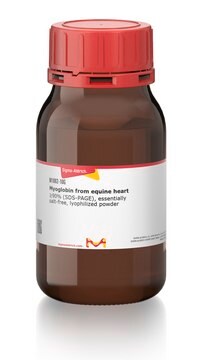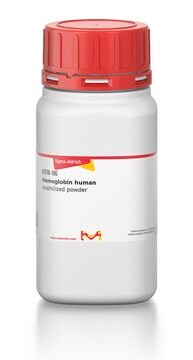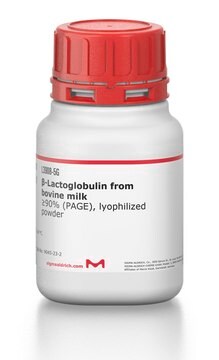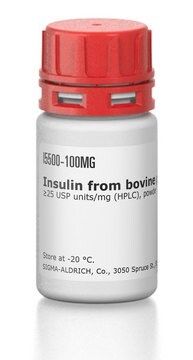M0630
Myoglobin from equine skeletal muscle
95-100%, essentially salt-free, lyophilized powder
Sinónimos:
Myoglobin from horse skeletal muscle
About This Item
Productos recomendados
origen biológico
equine skeletal muscle
Análisis
95-100%
formulario
essentially salt-free, lyophilized powder
mol peso
~17 kDa(lit.)
contenido de hierro
0.25-0.32%
técnicas
mass spectrometry (MS): suitable
solubilidad
H2O: soluble 10 mg/mL
Nº de acceso UniProt
temp. de almacenamiento
−20°C
Información sobre el gen
horse ... MB(100054434)
¿Está buscando productos similares? Visita Guía de comparación de productos
Aplicación
Acciones bioquímicas o fisiológicas
Aplicación
Código de clase de almacenamiento
11 - Combustible Solids
Clase de riesgo para el agua (WGK)
WGK 3
Punto de inflamabilidad (°F)
Not applicable
Punto de inflamabilidad (°C)
Not applicable
Equipo de protección personal
Eyeshields, Gloves, type N95 (US)
Certificados de análisis (COA)
Busque Certificados de análisis (COA) introduciendo el número de lote del producto. Los números de lote se encuentran en la etiqueta del producto después de las palabras «Lot» o «Batch»
¿Ya tiene este producto?
Encuentre la documentación para los productos que ha comprado recientemente en la Biblioteca de documentos.
Los clientes también vieron
Artículos
Professor Ebrahimi and Professor Robinson (Pennsylvania State University, USA) summarize recent advances in the synthesis of these 2D materials, resulting material properties, and related applications in biosensing of neurotransmitters, metabolites, proteins, nucleic acids, bacterial cells, and heavy metals.
Chromatograms
application for HPLCNuestro equipo de científicos tiene experiencia en todas las áreas de investigación: Ciencias de la vida, Ciencia de los materiales, Síntesis química, Cromatografía, Analítica y muchas otras.
Póngase en contacto con el Servicio técnico










